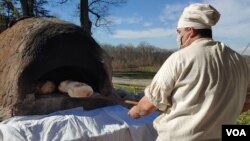ALEXANDRIA, VIRGINIA —
Justin Cherry watches the woodburning fire inside his mound-shaped clay oven. He sticks his hand into the mouth of the oven to feel the heat, waiting for the clay surface inside to get hot enough to bake his homemade bread, which he makes the way it would have been done in the 1700s.
Cherry is at Mount Vernon, a historical attraction in Alexandria, Virginia, which is the planation home of George Washington, who served as the first U.S. president from 1789-1797. Dressed in 18th-century garb, Cherry uses a wooden baking paddle to place a few of the loaves at a time into the oven.
"Using the wood, I heat the oven for about five hours," he said, "and it stays hot for about four hours, and I get around 50 loaves of bread from one fire."
Known as a beehive, baking ovens like this were common in 18th century households.
The historically accurate oven I use is made of clay, mortar and rice straw and is mobile so I can travel with it to different historical sites in the country," said Cherry, a chef and owner of the Half Crown Bakehouse, who makes a living selling the bread and other food items.
Cherry, 38, a history buff, combined his passion for 18th century food with his love of historical reenactments he did as a child, to become a Colonial baker.
His mother, LuAnn Cherry, said baking runs in the family.
"Justin always liked baking and watched me bake when he was growing up. My mother baked bread and her father had a bakery, so this is a family tradition."
Besides bread, Cherry also makes cakes, cookies and pies, inspired by recipes from the 1700s.
"Cookbooks back then were only available to people who could afford them," he told VOA. "I take what I've learned through my research and combine it with my knowledge of modern baking."
In 2019, Cherry was selected as a fellow at Mount Vernon's Washington Library where he researched 18th century foodways. Later, he was named Mount Vernon's resident baker where he attends events, sharing his knowledge with visitors while showcasing his bread-making skills.
"It smells amazing, and I like the smokiness and earthy taste," said visitor Maggie Coleman from Georgia.
Dan Shippey, who portrays George Washington at Mount Vernon, stopped by to get a taste of bread and hoecakes made from corn.
"I normally start my day with hoecakes with a good deal of butter and honey," said Shippey in character. "I don't think there is anyone more skilled at making the finest bread than Justin Cherry."
"I can imagine eating this during George Washington's time," said visitor and history teacher Kendra Czernicki from Massachusetts.
Cherry mixes, kneads, proofs and bakes the bread by hand, a process he calls "calming and therapeutic."
He begins by blending flour, water, salt and ale yeast. "The process is not much different today," he said.
But what is different, he noted, is the flour used to make today's bread is enriched and bleached, unlike the bread of yesteryear.
Cherry said his bread is made solely from heritage grains — that go back to the 18th century — that he finds at a small farm in Maryland and a mill in South Carolina.
Leslie Bird, Mount Vernon historic gardens and landscape manager, makes it a point to buy Cherry's bread when he is at the estate.
"I am gluten intolerant, which means I usually can't eat bread," Bird said. "But I think because his bread contains only heritage grains, I can eat it without getting a bad reaction."
Cherry points out that George Washington was not only the first U.S. president, but he was also one of the country's first large-scale wheat farmers.
"He experimented with growing wheat, and at one point was working with 16 different kinds of wheat," he said.
Cherry is working on a cookbook to preserve 18th century culinary history. "I not only want people to learn about the different kinds of food," he said, “but why the food is an important part of our history."




